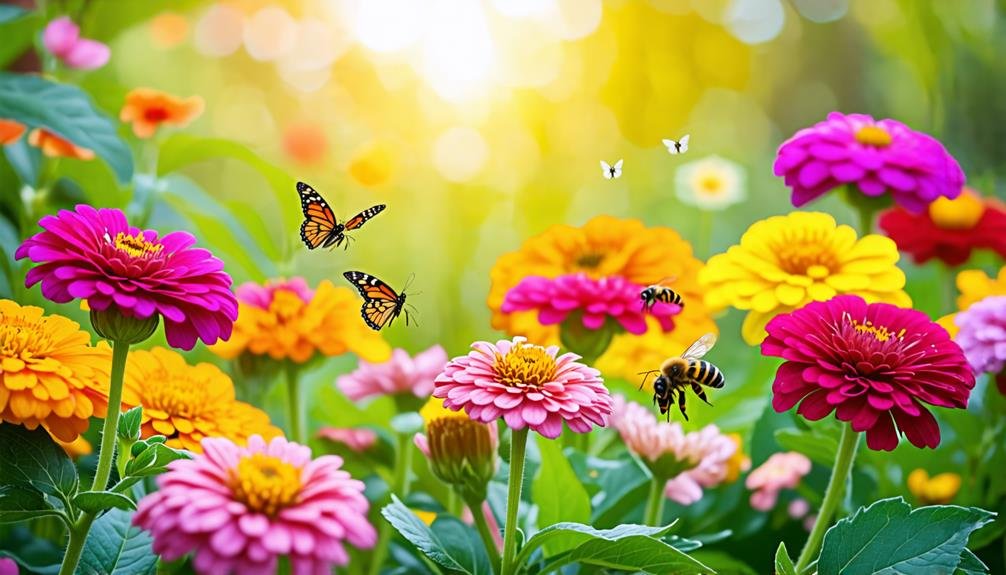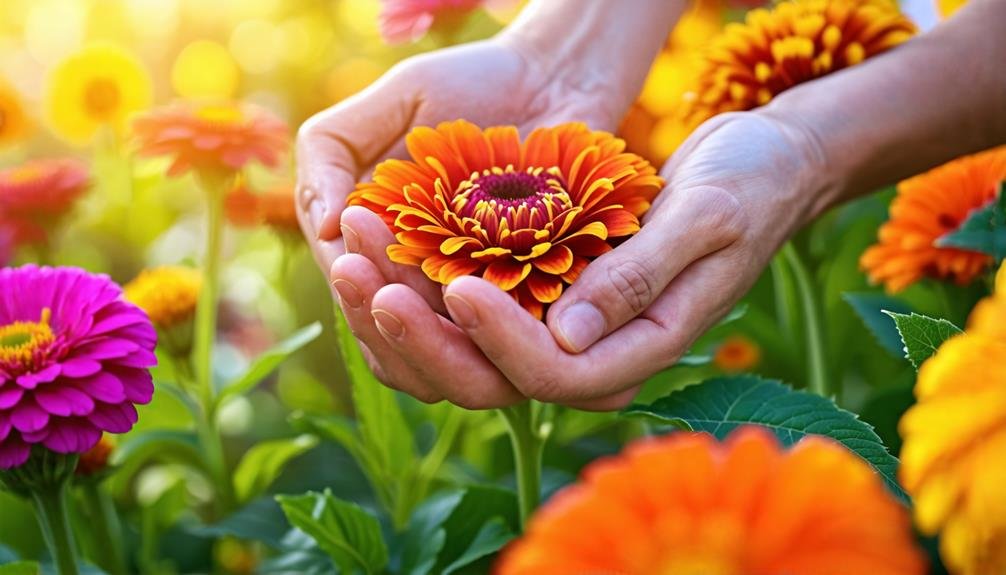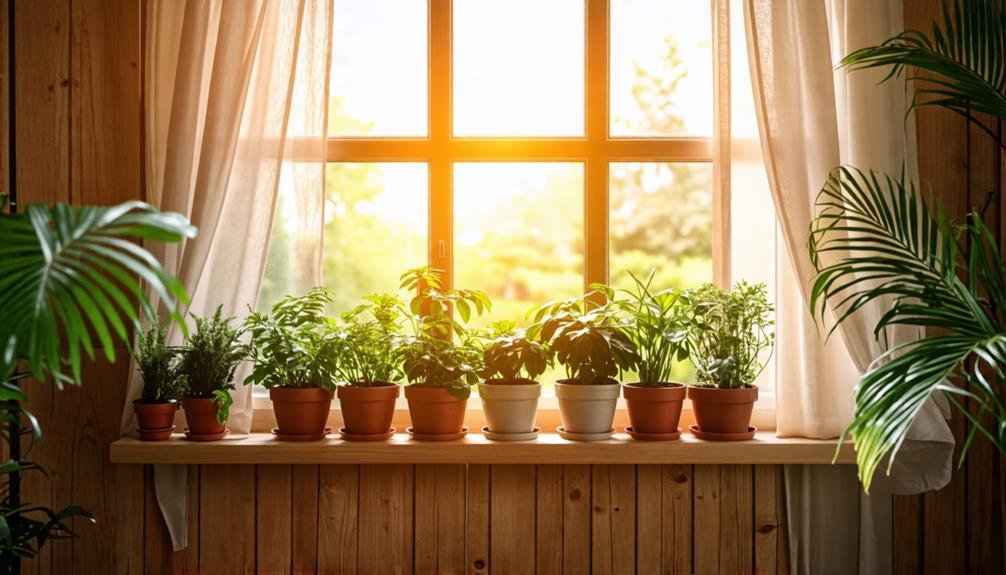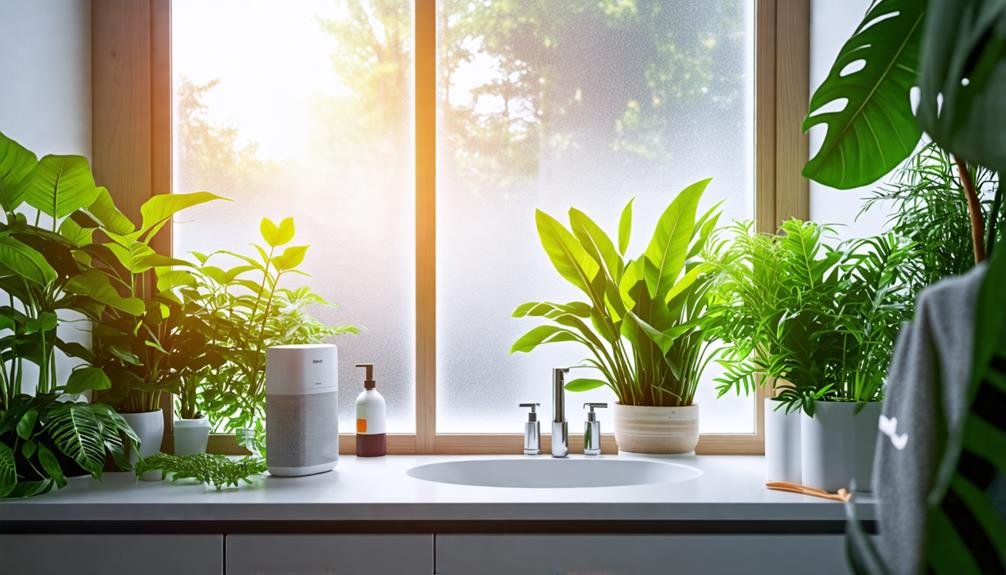To plant zinnia seeds successfully, time your planting between May and early July, ensuring soil temperatures reach at least 60°F. You can choose to plant seeds directly in the ground or start them in seed trays, depending on your region and gardening goals. Use well-draining, nutrient-rich soil with a pH of 6.0 to 7.0, and sow seeds no deeper than ¼ inch, spacing them 1 to 2 feet apart. Keep the soil consistently moist, and apply a balanced fertilizer monthly. Proper planting and care will yield vibrant blooms, enhancing your garden's aesthetic appeal while attracting crucial pollinators. Further insights await to optimize your gardening adventure.
Best Time to Plant Zinnias
Choosing the right time to plant zinnias is essential for ensuring a lively and colorful garden throughout the growing season. Zinnia seeds should ideally be sown a few weeks after the last frost, as these flowers prefer warm temperatures. In many areas, the months of May to early July provide optimal conditions for planting zinnia seeds, allowing enough time for the plants to thrive.
Zinnias are adaptable garden blooms that can be cultivated as annuals in USDA zones 2 through 11. It's crucial to wait until soil temperatures reach at least 60°F before transplanting, as this encourages robust growth. In southern regions, zinnias can be planted well into August, offering a chance for beautiful blooms before the season ends.
For zinnia care, select a planting site that receives full sunlight and has well-draining, nutrient-rich soil. Spacing the plants 1-2 feet apart promotes adequate air circulation, minimizing the risk of disease. Water the plants when the soil feels dry, and consider applying a phosphorus-rich fertilizer monthly to promote vigorous growth and vibrant flowers.
Direct Sowing Vs. Seed Trays
When considering planting zinnias, gardeners face the choice between direct sowing and using seed trays, each method offering distinct benefits. Direct sowing allows for a straightforward approach, promoting strong root development in the garden's native soil, while seed trays provide better control over growth conditions and timing. Understanding the advantages of each method can help guarantee successful germination and vibrant blooms throughout the season.
Benefits of Direct Sowing
Planting zinnia seeds directly in your garden offers several benefits. This method reduces transplant shock and helps develop a stronger root system. When seeds are sown in their final location, they adapt to the local soil and climate, establishing a solid foundation for growth. This approach allows zinnias to create a deep root network, enhancing their ability to absorb nutrients and endure dry conditions.
Additionally, direct sowing streamlines the planting process. Gardeners can easily plant extensive areas with zinnias without needing seed trays or moving seedlings. This not only saves time but also reduces the effort typically involved in nurturing young plants indoors before transferring them outside.
Moreover, direct sowing supports a balanced garden ecosystem. As zinnias flourish, they attract beneficial insects like bees and butterflies, which improve the overall vitality of your garden. By opting for direct sowing, you can cultivate a lively and thriving garden, showcasing the beauty and resilience of zinnias while enjoying a more relaxed gardening experience.
Advantages of Seed Trays
Seed trays provide numerous benefits compared to direct sowing, particularly regarding control and early growth management. They enable gardeners to systematically plant, allowing for close monitoring of individual seedlings. This controlled setting fosters healthier development by reducing competition for essential resources like sunlight, moisture, and nutrients.
Additionally, seed trays support earlier planting, as seeds can be initiated indoors or in sheltered spaces, effectively lengthening the growing season. After seedlings establish robust root systems, they can be transferred to outdoor gardens, minimizing the chances of harm from pests and unpredictable weather.
Managing soil conditions becomes simpler with seed trays, as they allow for the use of high-quality, well-draining potting mixes. This can enhance germination rates and the overall vitality of the plants.
Furthermore, the portability of seed trays lets gardeners position them in optimal lighting conditions, further aiding seedling growth. In contrast, direct sowing often results in uneven germination and difficulties in maintaining ideal growing environments. For those aiming to grow zinnias with precision and care, seed trays offer an appealing alternative.
Timing for Best Results
Timing is crucial for achieving optimal results when deciding between direct sowing and using seed trays for planting zinnias. Zinnia seeds flourish when planted directly in the garden from a few weeks post-last frost until mid-summer. This approach allows seeds to germinate in their natural habitat, fostering healthy growth that adapts well to the garden ecosystem.
On the other hand, using seed trays can provide an advantage for gardeners looking to kickstart the growing season. By starting seeds indoors several weeks before the last frost, gardeners can create a controlled environment that encourages earlier blooming. This method is especially useful in areas with limited growing seasons or erratic weather patterns.
Both planting techniques have their benefits, but the best choice hinges on regional climate factors and individual gardening styles. In southern climates, direct sowing can extend into late summer, while northern regions may benefit more from using seed trays to enhance flowering opportunities. Ultimately, grasping the timing and conditions for each method enables gardeners to nurture vibrant zinnias, enriching their landscapes with stunning blooms.
Soil Requirements for Zinnias

To successfully cultivate zinnias, understanding soil requirements is important. Well-draining, fertile soil not only supports healthy root development but also guarantees that zinnias receive the necessary nutrients for robust growth. Moreover, maintaining a balanced soil moisture level is vital, as overly saturated conditions can hinder plant health and lead to root rot.
Soil Drainage Importance
Well-draining soil is essential for the growth of zinnias, as it helps prevent root rot and fosters healthy development in these colorful annuals. Zinnias flourish in environments where excess water can drain swiftly, allowing their roots to access the oxygen necessary for optimal growth. Inadequate drainage can create waterlogged conditions, which not only impede growth but also promote fungal diseases that can compromise the plant's health.
To ensure proper drainage, pay attention to the soil composition when planting zinnias. A blend of sandy loam and organic materials, such as Miracle-Gro® Garden Soil, can significantly enhance drainage while retaining vital moisture. Additionally, utilizing raised beds or mounded soil can further improve drainage in areas with dense clay soils, ensuring zinnias thrive without the threat of standing water.
Regularly assessing the soil's drainage capabilities before planting is also advisable. Conduct a simple percolation test: dig a hole, fill it with water, and monitor how long it takes to drain. If the water does not drain quickly, consider adding amendments or choosing a different planting location. By prioritizing effective soil drainage, gardeners can enjoy a vibrant display of zinnias throughout the growing season.
Fertility and Nutrients
Healthy zinnias require nutrient-rich soil that supports their vibrant growth and flowering. To achieve this, focus on soil fertility and composition. Zinnias thrive in well-draining substrates that are enriched with organic matter, which can be enhanced by adding compost or well-rotted manure. The ideal pH level for zinnia cultivation falls between 6.0 and 7.0, promoting optimal nutrient availability.
In terms of nutrient needs, zinnias respond well to balanced fertilizers, particularly those high in phosphorus, as phosphorus encourages root development and flowering. It is recommended to apply fertilizers like Miracle-Gro monthly during the growing season to ensure zinnias receive the essential nutrients for vigorous growth.
Moreover, sufficient moisture retention is crucial. While zinnias exhibit drought resistance, consistent watering is important, particularly during dry periods, to maintain soil fertility. Regular soil nutrient testing can identify any deficiencies, allowing for timely adjustments. By prioritizing these soil conditions, gardeners can nurture zinnias that bloom beautifully and enhance the vibrancy of their garden landscapes.
Proper Planting Depth and Spacing
When sowing zinnia seeds, it's essential to ensure they are placed at a depth of ¼ inch and spaced 1 to 2 feet apart for optimal growth and vibrant blooms. This specific planting depth helps the seeds absorb adequate warmth and moisture, while also minimizing the likelihood of pest infestations and diseases. Proper spacing is crucial, as it allows for sufficient air circulation around each flower, lowering the chances of fungal issues and ensuring they receive plenty of sunlight.
For the best results, keep these tips in mind:
- Seed Depth: Sow zinnia seeds no deeper than ¼ inch to encourage rapid germination.
- Spacing: Space each seed 1 to 2 feet apart to foster healthy growth and avoid overcrowding.
Watering and Fertilization Tips

Proper hydration and suitable fertilization are essential for zinnia plants to thrive and produce vivid flowers throughout the growing season. Zinnias need consistent moisture, particularly during their early growth stages. It is best to irrigate the plants when the top inch of soil is dry to the touch, as excessive watering can cause root rot. Employing a deep watering technique that allows moisture to reach the root zone is more advantageous than frequent shallow irrigation. This method encourages strong root development, making the plants more resilient to drought.
For fertilization, zinnias respond well to a phosphorus-rich fertilizer, which supports flowering and overall plant health. Monthly applications during the growing season help maintain nutrient levels. A balanced, slow-release fertilizer brand like Miracle-Gro can also be effective, providing a continuous supply of nutrients without overwhelming the plants.
Additionally, integrating organic matter such as compost can enhance soil fertility and structure, creating a healthier environment for growth. By adhering to these watering and fertilization guidelines, gardeners can establish conditions that enable zinnias to flourish, resulting in a stunning array of colors and forms that beautify any garden space.
Zinnias for Garden Aesthetics
Zinnias offer an impressive array of colorful varieties, making them a versatile choice for enhancing garden aesthetics. By strategically planting these flowers, gardeners can benefit from a vibrant display throughout the growing season, as zinnias bloom profusely with minimal maintenance. Their adaptability allows for creative combinations, ensuring that every garden can achieve a personalized and lively look.
Colorful Varieties Available
A diverse assortment of zinnia species provides vibrant shades and distinctive forms, making them a fantastic option for elevating garden beauty. These blooms present a palette of colors, enabling horticulturists to craft breathtaking visual arrangements. Whether seeking bold primary tones or delicate pastels, zinnias can enhance any garden design. The variety in form and size introduces additional appeal, with selections ranging from tall, elegant versions to compact, bushy varieties.
Consider adding these zinnia species to your garden:
- Zinnia elegans: Renowned for its iconic daisy-like blossoms, this type showcases hues from rich crimson to bright sunshine yellow.
- Zinnia angustifolia: A more compact choice, this variant features smaller blossoms and is ideal for borders or planters.
Seasonal Planting Benefits
Seasonal planting of zinnias enhances garden beauty and ensures a steady display of vivid colors throughout the growing season. By planning your planting schedule, you guarantee that these resilient blooms flourish from late spring into fall. This timing creates a dynamic garden that evolves, attracting attention to your outdoor space and fostering a welcoming atmosphere.
Zinnias thrive in full sunlight, making them perfect for brightening any garden area. Their diverse sizes and colors allow gardeners to create eye-catching contrasts or soothing blends based on individual tastes. Additionally, planting zinnias in clusters effectively fills gaps in your garden, reducing weed growth and boosting overall attractiveness.
Beyond visual appeal, zinnias attract vital pollinators like honeybees and monarch butterflies, enhancing garden biodiversity. This natural pollination not only supports zinnias but also benefits neighboring plants, including tomatoes and peppers. By adopting seasonal planting practices, gardeners can unleash their creativity, crafting a stunning and ecologically beneficial environment.
Attracting Pollinators With Zinnias

Adding zinnias to your garden enhances visual appeal while attracting essential pollinators like honeybees and monarch butterflies. These flowers are not merely decorative; they provide vital sustenance for these crucial insects, which play a key role in sustaining ecological health and food systems. By growing zinnias, you establish a welcoming environment that promotes pollinator activity, thereby enriching biodiversity in your landscape.
To maximize the pollinator-friendly benefits of zinnias, keep these tips in mind:
- Variety Selection: Opt for a variety of zinnia types to ensure a steady bloom throughout the season, giving pollinators consistent access to nectar and pollen.
- Plant Grouping: Arrange zinnias in clusters instead of solitary patches. This makes it easier for bees and butterflies to locate and move between these food sources.
Enhancing Vegetable Growth
Planting zinnias near tomato plants can enhance their growth by attracting essential pollinators. These colorful blooms guide bees and butterflies, which are vital for fertilizing many vegetable varieties. When zinnias blossom, their vivid hues create an inviting environment for these insects, resulting in improved yields for garden produce.
Furthermore, zinnias contribute to a healthier ecosystem in the garden. They suppress weed growth by filling empty spaces, allowing tomato plants and other vegetables more room and resources to flourish. The presence of zinnias may also repel specific pests that affect vegetable crops, serving as a natural pest control method.
Additionally, zinnias have been shown to enhance the growth of tomatoes specifically. By planting zinnias alongside these crops, gardeners establish a mutually beneficial relationship that promotes healthier plants. In essence, incorporating zinnias into your vegetable garden not only enhances its aesthetic appeal but also bolsters the health and productivity of your vegetable crops, ultimately fostering a more vibrant and fruitful garden environment.
Harvesting Zinnia Seeds

When zinnia blossoms start to wither and dry out, it's the ideal moment to collect seeds for next year's colorful garden. Gathering zinnia seeds is a simple task that ensures you have a fresh stock for planting in the next growing season. Start by choosing robust, mature blooms that have completely dried on the plant. The seeds are located in the center of the flower head, which is your main focus.
To successfully gather zinnia seeds, follow these essential steps:
- Snip the flower heads: Utilize sharp, sanitized scissors to cut the flower heads from the stem, ensuring a small segment of the stem remains for easier handling.
- Air-dry the seeds: Position the flower heads in a cool, dry area for several days to achieve full dryness, preventing mold during storage.
Regional Planting Guidelines
Understanding regional planting guidelines is essential for maximizing the growth and vibrancy of zinnias, enabling them to thrive in diverse climates and conditions. Zinnias, belonging to the Asteraceae family, flourish in USDA zones ranging from 2 to 11, providing flexibility for gardeners nationwide. In northern climates, it is recommended to sow zinnias a few weeks after the final frost until mid-summer, allowing sufficient time for their development.
Conversely, southern regions may extend their sowing period well into August, capitalizing on the warmer temperatures to achieve vibrant blooms before the season wraps up. Monitoring soil temperatures is crucial, as zinnias prefer a minimum of 60°F for successful transplanting.
For numerous localities, the prime planting months span from May through early July; however, specific climate conditions should always be taken into account. By following these guidelines, gardeners can choose the optimal time to plant zinnia seeds, resulting in a thriving garden filled with color and vitality. By recognizing these regional variations, you can express your unique gardening style and create a stunning zinnia display that harmonizes with your local environment.



















You must be logged in to post a comment Login